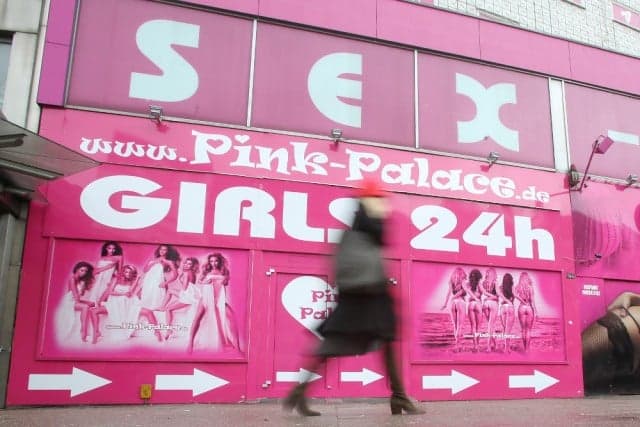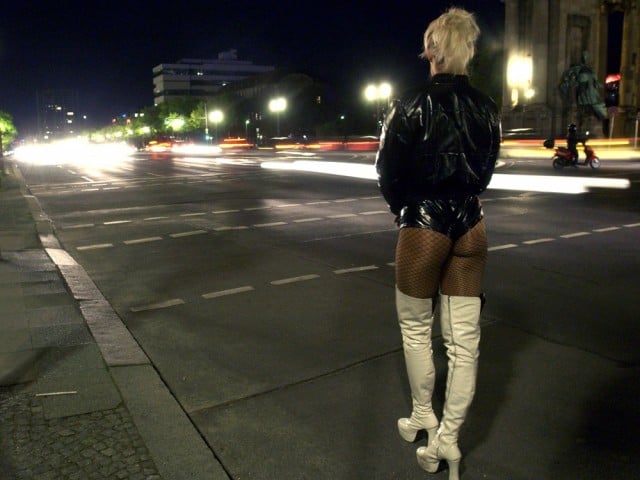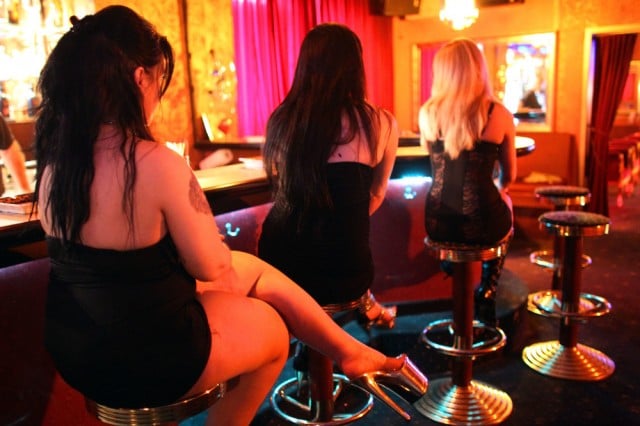Five things to know about prostitution in Germany

Prostitution has long been legal in Germany, and the country has been called "Europe's biggest brothel". But forced prostitution continues to be an issue as well. Here's a look at the history and policies.
1. How long has prostitution been legal?
Prostitution has actually been legal or tolerated in Germany throughout history. Even in the 1800s, police preferred a system of regulation so they could supervise prostitution, according to the book Prostitution by Eva-Maria Heberer.
Under King Friedrich Wilhelm IV, brothels were banned in large parts of Prussia for some years, and prostitutes had to be registered.
During the Weimar Republic, a campaign to fight venereal diseases adopted the notion that prostitution should not be criminalized, but rather controlled as far as where it could take place, such as not near schools or churches.
SEE ALSO: 'I come to Germany for prostitutes - it's like Aldi'
The Nazi regime implemented restrictions on prostitutes, and many cities banned the practice in public places. But prostitutes were also used by Adolf Hitler’s government to try to boost the performance of soldiers, as well as to reward prisoners at concentration camps - a manipulative method of creating competition and division. Gay men were also forced to have sex with female prostitutes to prove they were “healed”. Prostitutes were also considered "asocial" by the Nazis and sent to concentration camps.
When the country split in two at the start of the Cold War, the two nations had very different policies. The communist East German or GDR government made prostitution illegal, as commercial sex work seemed to contradict their socialist agenda. Still, the secret Stasi police would use prostitutes to blackmail people.
In West Germany, prostitution was regulated and legislation required sex workers to obtain health certificates.
Upon reunification, negotiations ultimately led to its current status as legalized.
Click here for all The Local's guides to Living in Germany
2. What about now?
 Photo: DPA
Photo: DPA
A law implemented in 2002 sought to improve the conditions for sex workers by allowing them to sue for their wages and become part of health, unemployment and pension programmes.
It's estimated that between 150,000 to 700,000 prostitutes work in Germany, according to DPA.
Minors under 18 may not work as prostitutes, and it is prohibited to perform sex work in the vicinity of a school where it might “corrupt juveniles”, as the German criminal code states. There are also restrictions on controlling a prostitute’s business - they themselves are supposed to be the ones in charge of determining “the place, time, extent, or other circumstances” of their work, not a pimp.
Local governments may place certain restrictions on prostitutes, such as restricting the practice in certain areas or at certain times.
Some estimates say that prostitution constitutes a €14.5 billion industry in Germany, and it’s the largest market in the EU, according to Spiegel. Some have even referred to Germany as "Europe’s biggest brothel".
After the last German elections in 2013, the coalition government that formed promised to reform prostitution laws and better combat human trafficking.
A law passed last year and set to go into effect this July will require johns to wear condoms, prostitutes to officially register, and also have sex workers undergo regular health counselling sessions. But the law has met with fierce criticism from sex worker groups and advocates who say it infringes upon their privacy and could encourage women to work illegally instead.
Magdeburg in Saxony-Anhalt opened this year Germany's very first advice centre for female and transgender prostitutes seeking help.
Click here for all The Local's guides to Visiting Germany
3. What about human trafficking?
Since the 2002 law took effect, there has been wide criticism that the legislation did not help, and in fact made things easier for human traffickers, who could pose often foreign women as freely working professionals, despite the women actually being under duress.
The most recent statistics from 2015 collected by the Federal Criminal Police Office (BKA) show that the number of cases of human trafficking involving forced sexual exploitation rose by about 5 percent over the previous year to 505. About one-fourth of investigations into human trafficking involved solely German victims, and another one-fifth of victims were under 18.
But convicting human traffickers can be extremely difficult, the BKA notes in one report, because it is “difficult to provide proof that would hold up in court”, according to Spiegel.
There is “little willingness to cooperate with the police and assistance agencies, especially in the case of presumed victims from Romania or Bulgaria,” the report continues.
The law passed last year aimed at protecting prostitutes also compels johns to go to police when they see a sex worker who appears to be working against her will. Those who knowingly receive services from someone forced to do so face prison time.
4. What about ‘sex tourism’?
Due to the legal status, Germany’s prostitution scene is known to attract many foreign visitors. The small state of Saarland at the French border is popular for Frenchmen, according to Spiegel, while specialized travel agencies offer brothel tours in the country of up to eight days.
These holidays are promoted as “legal” and “safe” by promoters, and some services may also pick customers up at the airport to head straight for a club.
One American and frequent German sex tourist told The Local in 2013 that Germany was like “Aldi for prostitutes” because of the low prices.
5. Which regions are most known for prostitution?
 Photo: DPA
Photo: DPA
Berlin as the capital city is also a major stop for those looking to buy sex. It’s known for its flat-rate sex clubs or mega-brothels like Artemis, which was raided by police last year in an investigation into possible human trafficking.
Tourists to Berlin will also notice women lining up along the central Oranienburger Straße, ready to offer up their services.
Hamburg has a notorious red-light district along the Reeperbahn street. The most famous feature of this St. Pauli district is Herbertsraße, where women other than the prostitutes are warned to stay away.
When it comes to forced prostitution, Berlin had the highest number of investigations into such human trafficking in 2015 at 84 cases, followed by Germany’s most populous state of North-Rhine Westphalia at 78. Hamburg came in third at 46 investigations. The BKA reported that this is most likely due to the larger red-light districts in these states.
Comments
See Also
1. How long has prostitution been legal?
Prostitution has actually been legal or tolerated in Germany throughout history. Even in the 1800s, police preferred a system of regulation so they could supervise prostitution, according to the book Prostitution by Eva-Maria Heberer.
Under King Friedrich Wilhelm IV, brothels were banned in large parts of Prussia for some years, and prostitutes had to be registered.
During the Weimar Republic, a campaign to fight venereal diseases adopted the notion that prostitution should not be criminalized, but rather controlled as far as where it could take place, such as not near schools or churches.
SEE ALSO: 'I come to Germany for prostitutes - it's like Aldi'
The Nazi regime implemented restrictions on prostitutes, and many cities banned the practice in public places. But prostitutes were also used by Adolf Hitler’s government to try to boost the performance of soldiers, as well as to reward prisoners at concentration camps - a manipulative method of creating competition and division. Gay men were also forced to have sex with female prostitutes to prove they were “healed”. Prostitutes were also considered "asocial" by the Nazis and sent to concentration camps.
When the country split in two at the start of the Cold War, the two nations had very different policies. The communist East German or GDR government made prostitution illegal, as commercial sex work seemed to contradict their socialist agenda. Still, the secret Stasi police would use prostitutes to blackmail people.
In West Germany, prostitution was regulated and legislation required sex workers to obtain health certificates.
Upon reunification, negotiations ultimately led to its current status as legalized.
Click here for all The Local's guides to Living in Germany
2. What about now?
 Photo: DPA
Photo: DPA
A law implemented in 2002 sought to improve the conditions for sex workers by allowing them to sue for their wages and become part of health, unemployment and pension programmes.
It's estimated that between 150,000 to 700,000 prostitutes work in Germany, according to DPA.
Minors under 18 may not work as prostitutes, and it is prohibited to perform sex work in the vicinity of a school where it might “corrupt juveniles”, as the German criminal code states. There are also restrictions on controlling a prostitute’s business - they themselves are supposed to be the ones in charge of determining “the place, time, extent, or other circumstances” of their work, not a pimp.
Local governments may place certain restrictions on prostitutes, such as restricting the practice in certain areas or at certain times.
Some estimates say that prostitution constitutes a €14.5 billion industry in Germany, and it’s the largest market in the EU, according to Spiegel. Some have even referred to Germany as "Europe’s biggest brothel".
After the last German elections in 2013, the coalition government that formed promised to reform prostitution laws and better combat human trafficking.
A law passed last year and set to go into effect this July will require johns to wear condoms, prostitutes to officially register, and also have sex workers undergo regular health counselling sessions. But the law has met with fierce criticism from sex worker groups and advocates who say it infringes upon their privacy and could encourage women to work illegally instead.
Magdeburg in Saxony-Anhalt opened this year Germany's very first advice centre for female and transgender prostitutes seeking help.
Click here for all The Local's guides to Visiting Germany
3. What about human trafficking?
Since the 2002 law took effect, there has been wide criticism that the legislation did not help, and in fact made things easier for human traffickers, who could pose often foreign women as freely working professionals, despite the women actually being under duress.
The most recent statistics from 2015 collected by the Federal Criminal Police Office (BKA) show that the number of cases of human trafficking involving forced sexual exploitation rose by about 5 percent over the previous year to 505. About one-fourth of investigations into human trafficking involved solely German victims, and another one-fifth of victims were under 18.
But convicting human traffickers can be extremely difficult, the BKA notes in one report, because it is “difficult to provide proof that would hold up in court”, according to Spiegel.
There is “little willingness to cooperate with the police and assistance agencies, especially in the case of presumed victims from Romania or Bulgaria,” the report continues.
The law passed last year aimed at protecting prostitutes also compels johns to go to police when they see a sex worker who appears to be working against her will. Those who knowingly receive services from someone forced to do so face prison time.
4. What about ‘sex tourism’?
Due to the legal status, Germany’s prostitution scene is known to attract many foreign visitors. The small state of Saarland at the French border is popular for Frenchmen, according to Spiegel, while specialized travel agencies offer brothel tours in the country of up to eight days.
These holidays are promoted as “legal” and “safe” by promoters, and some services may also pick customers up at the airport to head straight for a club.
One American and frequent German sex tourist told The Local in 2013 that Germany was like “Aldi for prostitutes” because of the low prices.
5. Which regions are most known for prostitution?
 Photo: DPA
Photo: DPA
Berlin as the capital city is also a major stop for those looking to buy sex. It’s known for its flat-rate sex clubs or mega-brothels like Artemis, which was raided by police last year in an investigation into possible human trafficking.
Tourists to Berlin will also notice women lining up along the central Oranienburger Straße, ready to offer up their services.
Hamburg has a notorious red-light district along the Reeperbahn street. The most famous feature of this St. Pauli district is Herbertsraße, where women other than the prostitutes are warned to stay away.
When it comes to forced prostitution, Berlin had the highest number of investigations into such human trafficking in 2015 at 84 cases, followed by Germany’s most populous state of North-Rhine Westphalia at 78. Hamburg came in third at 46 investigations. The BKA reported that this is most likely due to the larger red-light districts in these states.
Join the conversation in our comments section below. Share your own views and experience and if you have a question or suggestion for our journalists then email us at [email protected].
Please keep comments civil, constructive and on topic – and make sure to read our terms of use before getting involved.
Please log in here to leave a comment.